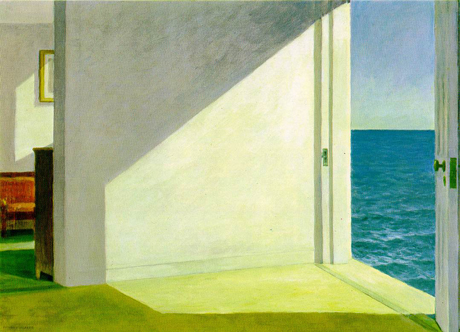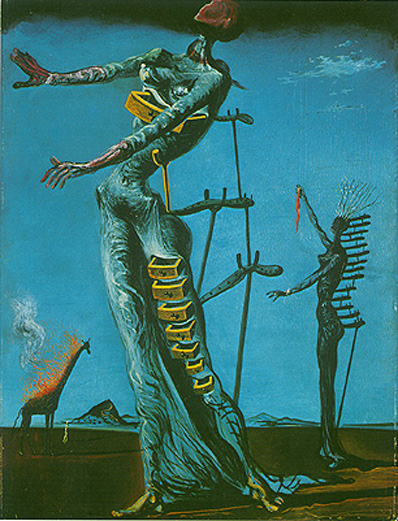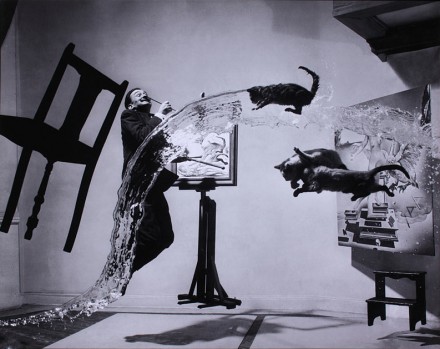Over the years, I’ve had a couple of major influences on my artwork. If you’re an artist or musician, I’m sure you can relate. Maybe you had a “blue period” like Picasso, or you were obsessed with Joe Satriani’s riffs.
Looking at my own art, I see three main periods where I was influenced by a particular artist or movement:
- Salvador Dalí/Surrealism
- Vincent Van Gogh
- Edward Hopper
1997 – 1999: Salvador Dalí

In high school and my freshman and sophomore years of college, I was really into Salvador Dalì. That was also when I got into Pink Floyd. My freshman year roomate coveted the drawing I did that was largely inspired by The Wall and Dark Side of the Moon. He still emails me about it about once a year. (I actually don’t know what has become of this piece. My wife thinks it got damaged and we had to throw it away. Sorry, Nick.)
That particular piece depicts a desolate nighttime landscape and floating bricks and a huge floating empty face and obscure personal references to heartache and lost love. The stuff of late adolescence, to be sure. It was definitely a “tortured poet” phase for me.
2000 – 2005: Vincent Van Gogh

Later in college I started gravitating toward a blue-and-yellow palette, somewhat reminiscent of Van Gogh. I also painted a bunch of café scenes of the Midnight Oil coffee house just off campus where I went to college. I began toning nearly every canvas with bright blue or some other strong, bright color before painting it. Occasionally I still use this technique, but the blue and yellow scheme has evolved into a mostly blue and brown scheme now. I would intentionally leave pockets of bright color in between objects, where the canvas would “shine” through. Eventually I got tired of this and felt like a hack and stopped toning the canvas.
2002 – 2011: Edward Hopper

I started painting urban structures like highway overpasses, toning the canvases in bright colors. Eventually I got away from the bright toning, and adopted a grayer palette.
I was really intrigued by Stephen Magsig’s daily paintings of urban structures in Detroit. So my work evolved into the Nashville365 series, which I got sick of and probably gave myself a huge creative injury trying to do.
In doing so, I came to think of it as way too derivative of Edward Hopper, since Hopper did that 60 years ago.
Hopper already did it, so why should I? I have to consider art history and what’s been done before.
And that’s where I got stuck.
I felt like I was retreading where Art had already gone, so why should I bother doing the same thing? Then for various personal reasons (like starting a family and an exhausting day job), I got away from painting due to my own stuckness and perceived lack of time. Then I guess I fell out of the habit of doing art on a regular basis.
Looking forward
In 2011, I got an iPhone and immediately downloaded
Instagram, an app that allows you to take and share photos. It has retro-inspired filters for your photos, and it makes sharing, commenting, and “liking” easy. Instagram reawakened a love for photography and image-making when I was mired in stuckness. It opened my eyes back up to seeing interesting things around me.

So now, instead of creating research images with a bulky SLR, I whip out my phone and snap a photo. If it’s good, I can find a way to work it into a painting. That’s what happened with my last major work, “Melrose Interchange.” I took a bunch of photos with Hipstamatic, reworked them heavily in Photoshop, and used those printouts as reference for the painting.
 I’m also growing more interested in visual abstraction in the world around us, especially when things are obscured by clouds or fog. It makes me feel most peaceful and quiet. So lately when I do have the chance to get in the studio, that’s what I try to make, on small (but not tiny) canvases that I can make significant progress on in an evening.
I’m also growing more interested in visual abstraction in the world around us, especially when things are obscured by clouds or fog. It makes me feel most peaceful and quiet. So lately when I do have the chance to get in the studio, that’s what I try to make, on small (but not tiny) canvases that I can make significant progress on in an evening.
What’s influenced you?
What artists have influenced you over the years? Can you point to anything specific during a particular time of your creative life? If so,
I’d love to hear it in the comments.
References
Girl with Curls
Salvador Dali
oil on panel, 20 × 15 3/4 inches. 1926.
Bedroom at Arles
Vincent Van Gogh
oil on canvas, 28.3 in × 35.4 inches. 1888
Cafe Terrace at Night
Vincent Van Gogh
oil on canvas, 31.8 in × 25.7 inches. 1888
Early Sunday Morning
Edward Hopper
oil on canvas, 35 3/16 × 60 1/4 inches. 1930
 For years, I’ve loved the art of Edward Hopper. I’m sure you’ve seen his famous “Nighthawks” painting. It’s one of the more famous pieces of 20th century American art, and has been spoofed and copied many times, influencing other visual artists and many filmmakers. Wim Wenders said that Hopper’s paintings appeal to filmmakers because “You can always tell where the camera is.” Evidently it was a huge influence on the look and feel of Blade Runner.
For years, I’ve loved the art of Edward Hopper. I’m sure you’ve seen his famous “Nighthawks” painting. It’s one of the more famous pieces of 20th century American art, and has been spoofed and copied many times, influencing other visual artists and many filmmakers. Wim Wenders said that Hopper’s paintings appeal to filmmakers because “You can always tell where the camera is.” Evidently it was a huge influence on the look and feel of Blade Runner.































